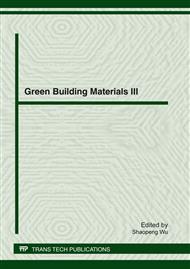[1]
W A Pisarski, J Pisarska, et. al. Luminescence Spectroscopy of Rare Earth-Doped Oxychloride Lead Borate Glasses, Journal of Luminescence, 131(2011) 649-652.
DOI: 10.1016/j.jlumin.2010.11.009
Google Scholar
[2]
J L Doualan, P Camy, R Moncorgé, et. al. Latest Developments of Bulk Crystals and Thin Films of Rare-Earth Doped CaF2 for Laser Applications, J. Fluorine Chem. 128 (2007) 459–464.
DOI: 10.1016/j.jfluchem.2006.12.017
Google Scholar
[3]
G Lakshminarayana, M Mao, R Yang, et. al. Spectroscopic Investigations of Nd3+, Er3+, Er3+/Yb3+, and Tm3+ Ions Doped SiO2–Al2O3–CaF2–GdF3 Glasses, Physica B: Condensed Matter, 404(2009) 3348-3355.
DOI: 10.1016/j.physb.2009.05.042
Google Scholar
[4]
J Fu, J M Parker, P S Flower, R M Brown, Eu2+ Ions and CaF2-Containing Transparent Glass-Ceramics, Mater. Res. Bull. 37 (2002) 1843–1849.
DOI: 10.1016/s0025-5408(02)00862-0
Google Scholar
[5]
C Li, Q Su, A New Blue Phosphorescent Glass-Ceramic: Rare-Earth-Doped Calcium Aluminoborate, J. Alloy Compd. 408–412(2006) 875–878.
DOI: 10.1016/j.jallcom.2004.12.062
Google Scholar
[6]
R Balakrishnaiah, R Vijaya, et. al. Characterization of Eu3+-doped fluorophosphate glasses for red emission, Journal of Non-Crystalline Solids, 353(2007)1397–1401.
DOI: 10.1016/j.jnoncrysol.2006.10.063
Google Scholar
[7]
J Cheng, P Tian, W Zheng, J Xie, Z Chen, Preparation and Spectral Analysis of a New Tb3+-Doped CaO-MgO-SiO2 Glass Ceramics, J. Alloy Compd. 471(2009) 470-473.
DOI: 10.1016/j.jallcom.2008.03.132
Google Scholar
[8]
P Tian, J Cheng, G Zhang, Z Chen, Q Wang, Crystallization and Luminescence Properties of Eu2+ Doped Diopside Glass Ceramics, Glass Physics and Chemistry, 36(2010) 431-435.
DOI: 10.1134/s1087659610040061
Google Scholar
[9]
J Cheng, P Tian, et. al. Preparation and Luminescent Properties of Sm3+ Doped CaO–MgO–SiO2 Glass Ceramics, J. Chn. Ceram. Soc. 36(2008)1017–1021.
Google Scholar
[10]
R Chakrabarti, M Das, et. al. Emission Analysis of Eu3+: CaO–La2O3–B2O3 Glass, Journal of Non-Crystalline Solids, 353(2007)1422.
DOI: 10.1016/j.jnoncrysol.2006.10.067
Google Scholar
[11]
A M Babu, B C Jamalaiah, et. al. Optical Properties of Eu3+Ions in Lead Tungstate Tellurite Glasses, Solid State Sciences, 13(2011)574-578.
DOI: 10.1016/j.solidstatesciences.2010.12.028
Google Scholar
[12]
M Nogami, Y Abe, Enhanced Emission from Eu2+ Ions in Sol‐Gel Derived Al2O3–SiO2 Glasses, Appl. Phys. Lett. 69(1996)3776-3778.
DOI: 10.1063/1.116995
Google Scholar
[13]
Y H Zhou, J Lin, S B Wang, H J Zhang, Preparation of Y3Al5O12: Eu Phosphors by Citric–Gel Method and Their Luminescent Properties, Optical Materials, 20(2002)13–20.
DOI: 10.1016/s0925-3467(02)00020-4
Google Scholar


